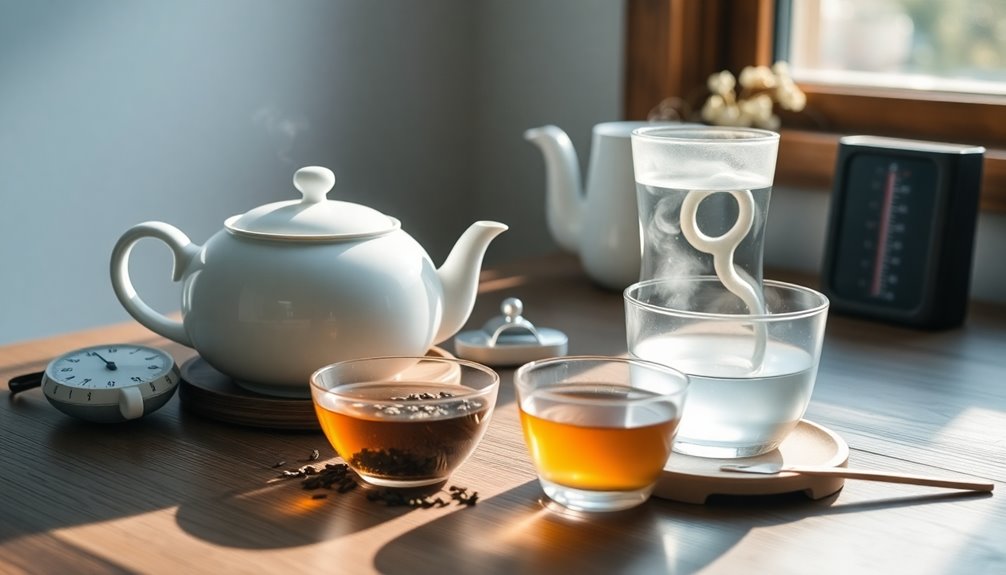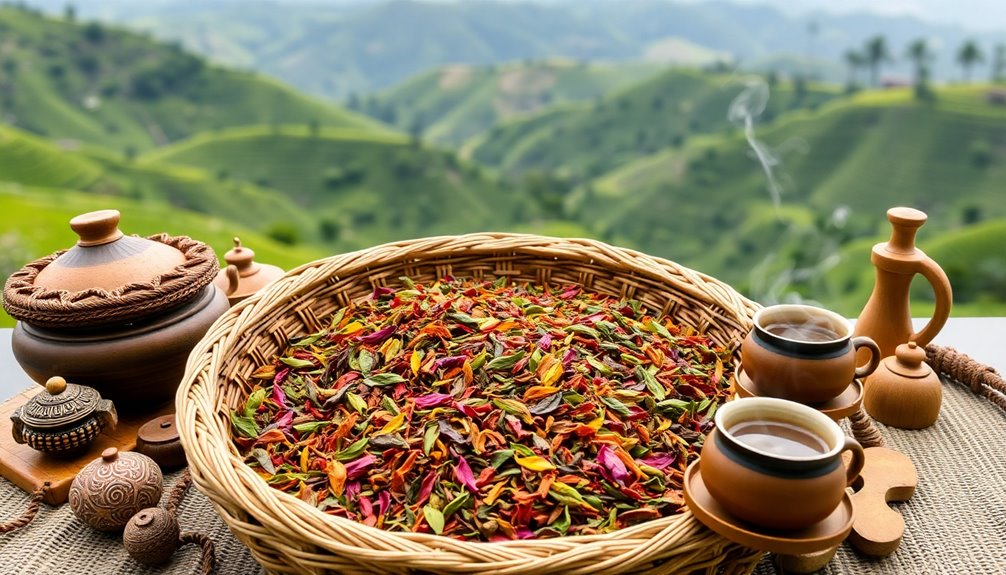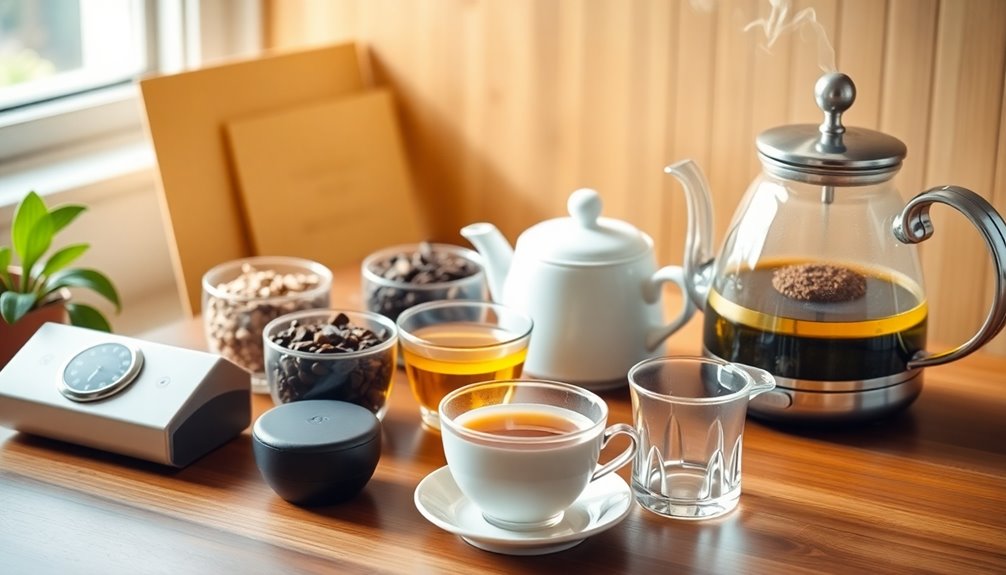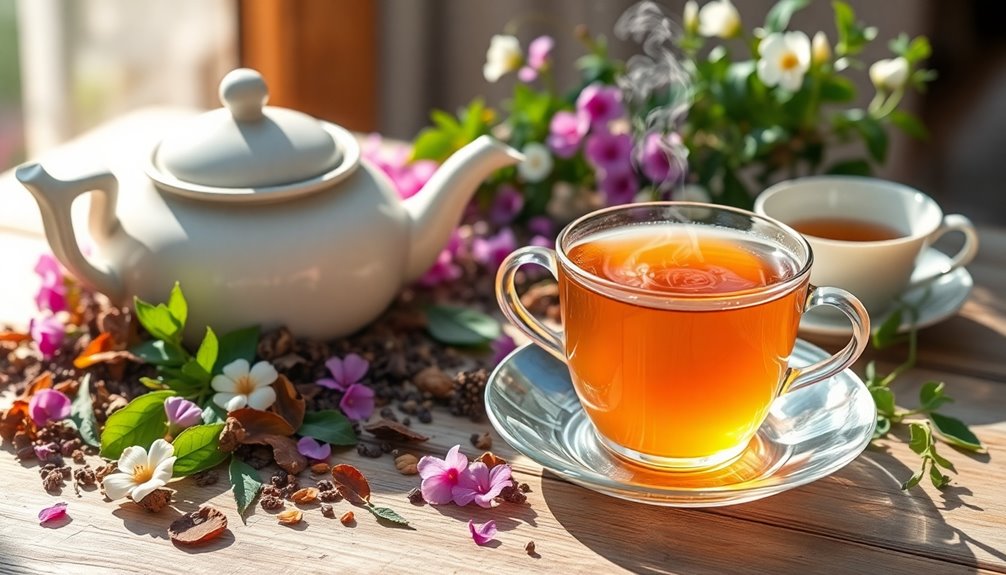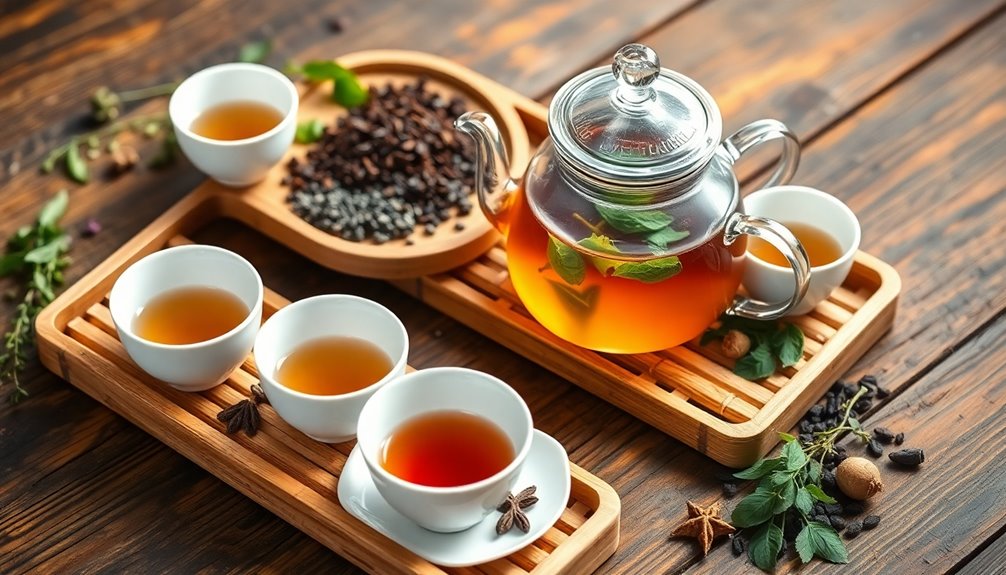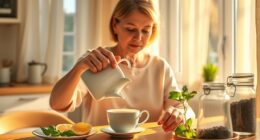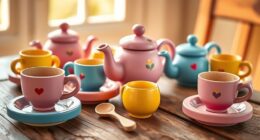The science behind the perfect tea brew is all about temperature, steeping time, and water quality! For black tea, you need water around 98-100°C, while green tea prefers a cooler 82°C. Steep black tea for about 4-5 minutes, and green tea for 2-3 minutes. If you steep too long, your tea could taste bitter—yikes! Using soft, filtered water helps make your brew taste amazing, too. Plus, pre-heating your teapot and cups ensures everything stays warm. So, grab your favorite tea and try these tips—who knows, you might just discover your new favorite brew waiting to be enjoyed!
Key Takeaways
- Different tea types require specific water temperatures: black tea at 98-100°C, green tea around 82°C, and herbal teas at boiling point.
- Optimal steeping times vary: black tea should steep for 4-5 minutes, while green tea can steep from 2-3 minutes to 15 minutes, depending on preference.
- Using filtered, soft water enhances flavor extraction and avoids bitterness, improving the overall tea experience.
- Pre-heating teapots and cups helps maintain consistent temperatures during brewing, ensuring optimal conditions for flavor development.
- Tea's health benefits stem from antioxidants and polyphenols, while caffeine levels vary by type, influencing alertness and relaxation.
Introduction
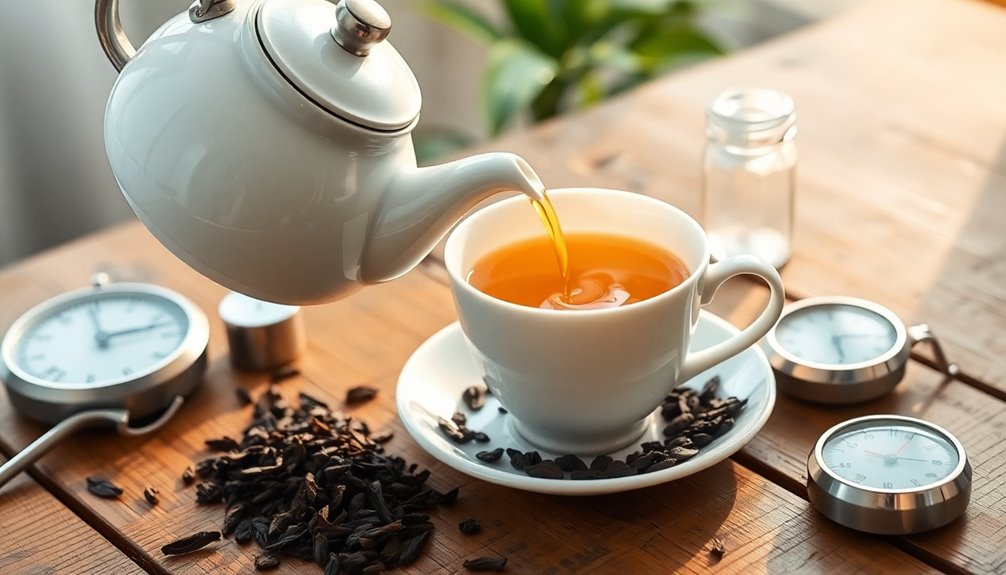
When it comes to brewing the perfect cup of tea, several key factors come into play. First, you need to think about the type of tea you're using, like black tea or green tea. Each type has its own special requirements for water temperature. For example, black tea loves hot water at around 98-100°C, while green tea prefers a cooler bath at about 82°C. Additionally, herbal teas often require boiling water to extract their unique flavors and benefits, and higher temperatures can enhance caffeine extraction for those teas that contain it.
Next, let's chat about steeping time! This is how long you let your tea leaves soak in the water. Generally, 3 to 5 minutes works best, depending on the tea. If you steep it too long, you might end up with a bitter taste, and nobody wants that!
Another important factor is the quality of your water. Softer water is kinder to your tea, making it taste even better. Plus, using loose leaf tea can really enhance the flavor and help you discover all the wonderful compounds that provide those amazing health benefits. To truly appreciate the nuances of each tea, consider exploring varieties like Oolong tea, which boasts a unique flavor profile that falls between green and black tea.
Tea's Historical Significance in Cultures
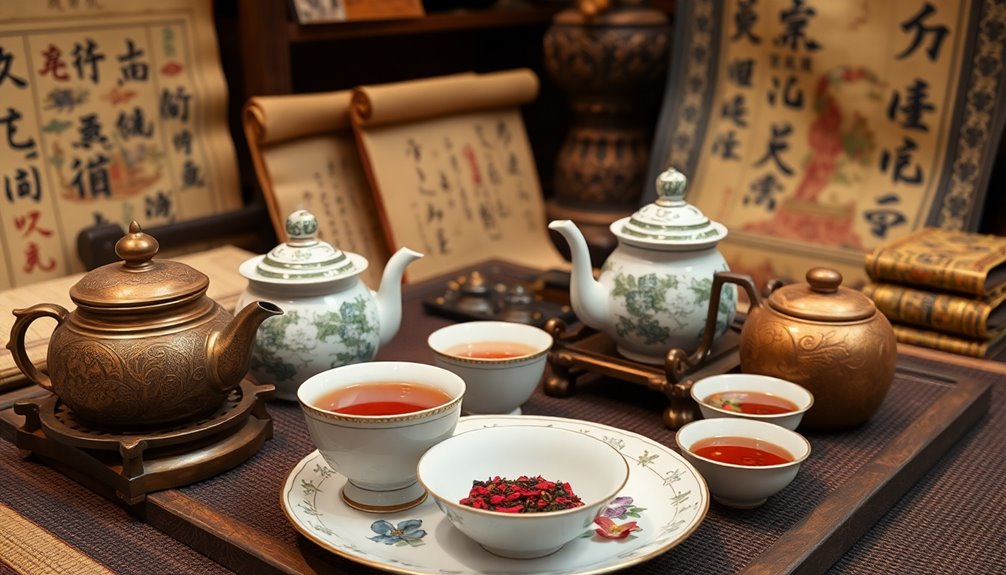
Steeped in history, tea has played a vital role in cultures around the world for over 4,000 years.
Originating in ancient China, it was cherished not just as a drink but also as a medicinal beverage. Imagine sipping a warm cup while thinking about its long journey through time! Tea has been recognized for its antimicrobial properties, which contribute to its medicinal uses. Additionally, tea's significance in historical societies parallels that of other staple foods like chia seeds, which were also revered for their nutritional value. The use of essential oils in conjunction with tea can further enhance its health benefits, creating a harmonious blend of flavors and aromas.
The first known tea tutorial, "Cha Jing," written by Lu Yu in 792 AD, laid the groundwork for tea cultivation and preparation, shaping tea culture for centuries.
Tea rituals, like the elegant Japanese tea ceremony, highlight mindfulness and bring people together, creating a sense of community. These beautiful traditions remind us of tea's historical significance in our lives.
Through trade routes, tea spread across continents, transforming economies and sparking cultural exchanges. You might even find clues about tea etiquette in British literature, where famous writers like George Orwell shared their thoughts on the perfect brew! Additionally, various herbal teas, such as chamomile and ginger, have been used for centuries for their medicinal properties, particularly in alleviating menstrual pain.
Optimal Steeping Temperature Ranges
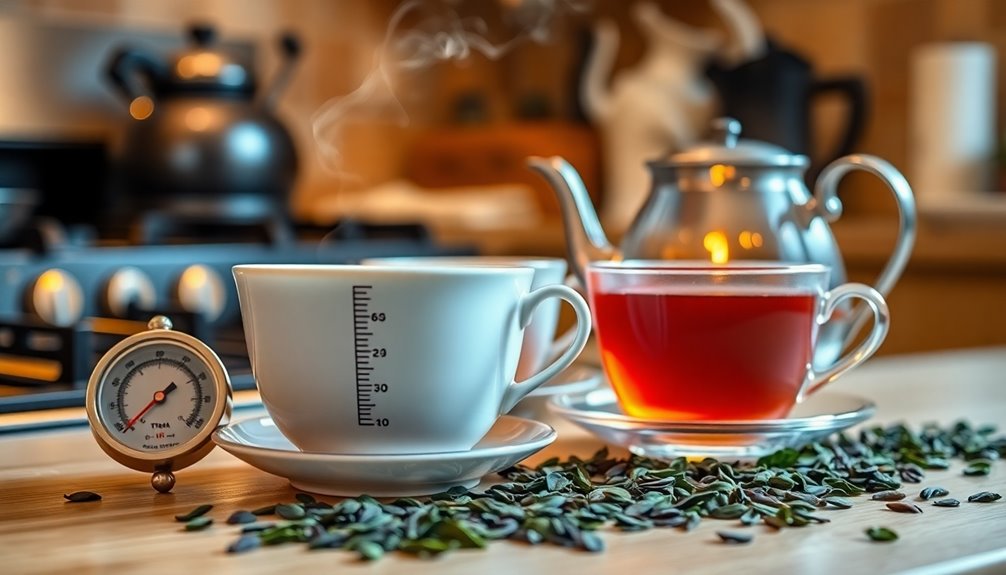
To get the most out of your tea experience, understanding the optimal steeping temperature is essential. Each type of tea has its own perfect brewing temperatures.
For example, green and white teas love to be brewed at lower temperatures, typically between 70-85°C (158-185°F). This helps keep their delicate flavors intact and prevents them from turning bitter.
On the other hand, black and oolong teas need a bit more heat! You should brew them at higher temperatures, around 85-100°C (185-212°F), to fully unlock their rich flavors and aromatic tea compounds.
If you're a fan of dark teas like Pu-erh, you can crank up the heat even more, sometimes exceeding 95°C (203°F).
But remember, brewing time matters too! Green teas steep for just 2-3 minutes, while black teas need 3-5 minutes, and oolong teas require 4-7 minutes.
If you use water that's too hot for sensitive teas, you might end up with a bitter taste. So, for every tea drinker, matching the right tea with the appropriate temperature is key to brewing that perfect cup of tea and enjoying every delightful sip! Additionally, incorporating ingredients like turmeric and ginger in your tea can enhance its health benefits, especially for those with inflammatory conditions.
Tea's Role in Mindfulness Practices
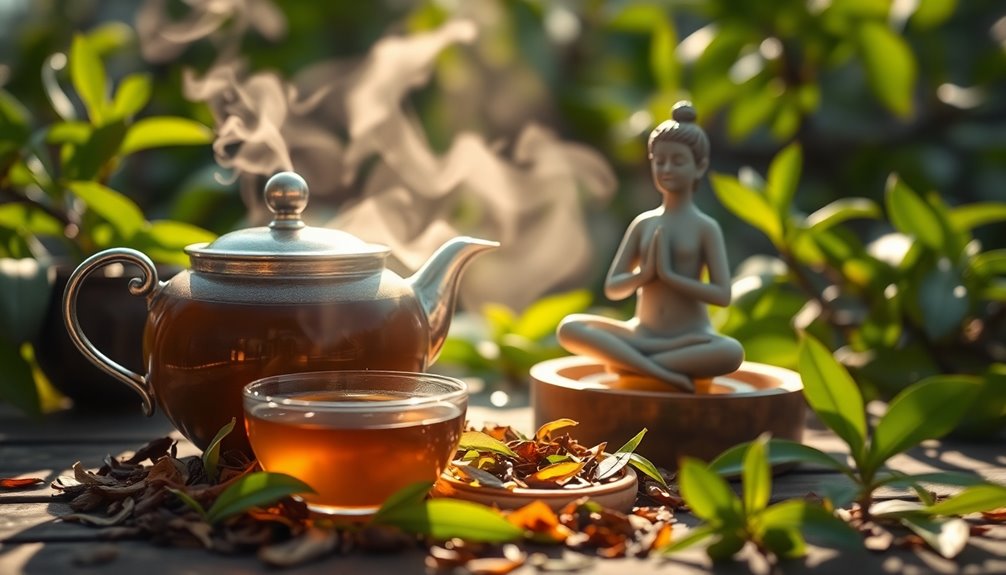
Tea serves as a powerful tool for embracing mindfulness in everyday life. When you brew tea, especially from camellia sinensis leaves, you engage in a delightful sensory experience. The process of watching tea leaves unfurl and infuse into hot water can feel like magic! As you focus on each step, you create a calming ritual that promotes relaxation and presence. Moreover, the global tea market, valued at approximately $200 billion in 2022, highlights the significance of this beverage in various cultures. Choosing the perfect tea kettle can further enhance your brewing experience by ensuring optimal temperature control.
Imagine preparing your perfect cup, paying close attention to the aromas wafting through the air. These delightful scents can help you feel more connected to the moment, encouraging you to breathe deeply and enjoy. The calming effects of tea can also mirror the benefits of listening to classical music, which enhances focus and promotes relaxation.
Sipping tea mindfully allows you to experience the flavors and sensations fully, making each sip a joyful celebration. Many cultures have tea rituals, like the Japanese tea ceremony, where every movement is intentional and thoughtful. Additionally, the philosophy of Zen Buddhism, which influences these rituals, emphasizes mindfulness and respect in each action taken during the ceremony.
Sharing a pot of tea with friends or family fosters connection and warmth, enhancing your mindfulness practice. Plus, the L-theanine in tea can help you feel even more relaxed, making it easier to stay centered.
Health Benefits Versus Caffeine Content
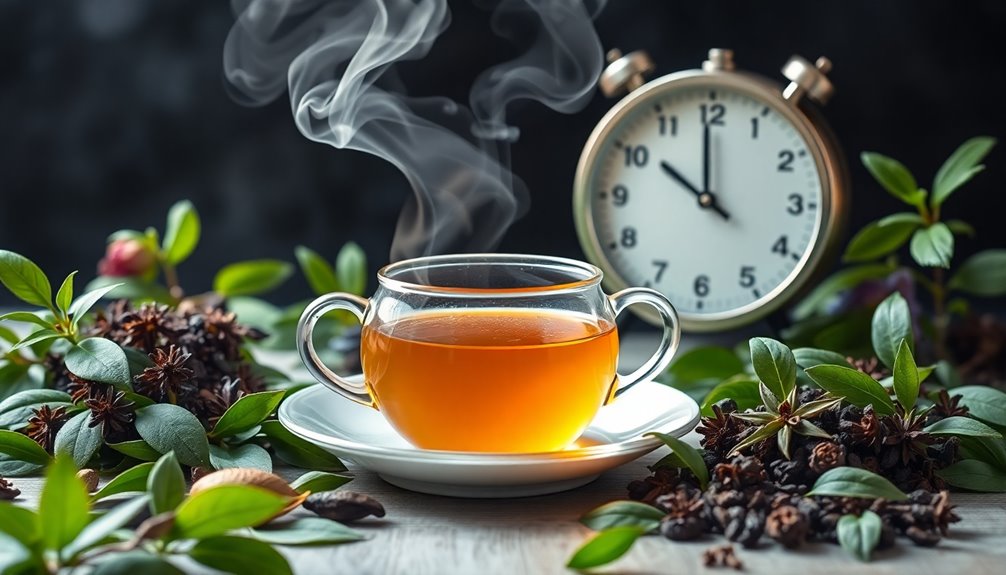
When considering the health benefits of tea, it's essential to balance its positive effects with caffeine content. Tea is a delightful drink packed with amazing antioxidant properties, especially from polyphenols and catechins. These compounds can help reduce the risk of heart disease and diabetes by fighting off pesky free radicals in your body. Additionally, incorporating foods high in dietary fiber can further enhance your overall health. The addition of essential oils can also complement tea's health benefits by providing antimicrobial properties. Notably, tea's antioxidant benefits may also contribute to improved cognitive function and mood enhancement.
Enjoying a cup of green tea or black tea can be a tasty way to boost your health!
However, remember that different types of tea have varying caffeine content. Black teas usually have the highest caffeine levels, around 40-70 mg per cup, while green tea contains less, about 20-45 mg. This means the energy you get from your tea can change based on what you choose.
But don't worry! The L-theanine in tea works wonders by balancing out caffeine's stimulating effects, making you feel relaxed yet focused. Additionally, certain scents from aromatherapy oils can enhance your overall mood and complement the benefits of tea.
Practical Applications
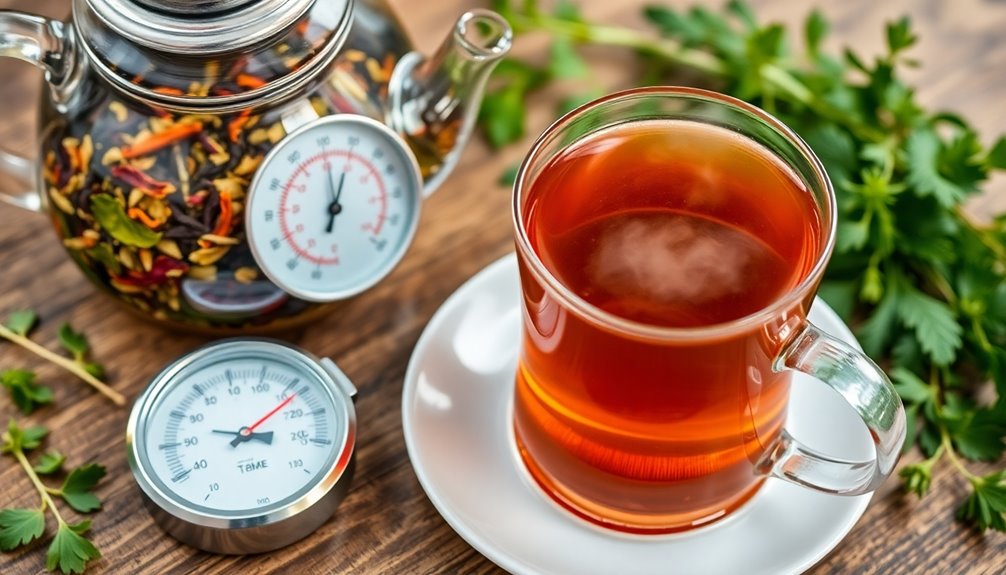
For a perfect cup of tea, mastering practical applications is key. First, think about your tea leaves. If you're brewing black or oolong tea, heat your water to around 98-100°C, but for green tea, aim for about 82°C. This way, you avoid bitterness and keep the yummy flavors!
Next, pay attention to steeping time. Black and oolong teas need about 4-5 minutes, while green tea can steep anywhere from 4 to 15 minutes, depending on how strong you like it.
Now, let's talk water! Using softer, filtered water really helps your tea shine. Hard water can create scum, which isn't what you want in your tea!
Don't forget to pre-heat your teapot and cups to keep that water temperature just right. It helps extract the amazing compounds in tea, making every sip delightful.
Frequently Asked Questions
How to Make the Perfect Cup of Tea Scientifically?
To make the perfect cup of tea, use filtered water, steep leaves at the right temperature, and pre-warm your vessel. Aim for about three minutes to balance flavor and avoid bitterness. Enjoy your brew!
What Is the Science Behind Tea Brewing?
When you brew tea, consider temperature, steeping time, and water quality. Adjust these factors based on tea type and personal taste, and experiment with leaf size to discover your ideal flavor profile. Enjoy the process!
What Is the Science Behind Tea Steeping?
When steeping tea, you need to consider time, temperature, and water quality. Each tea type has specific requirements; if you get it right, you'll enhance flavors and health benefits, avoiding bitterness or weak brews.
What Is Scientifically Happening as You Make a Cup of Tea?
As you brew tea, hot water extracts flavors and compounds from the leaves. Temperature and steeping time affect solubility, while water quality influences taste. Additives can enhance or alter the overall experience of your cup.
Conclusion
So, now you know the secrets to brewing the perfect cup of tea! With the right temperature, steeping time, and a sprinkle of mindfulness, you can enjoy all the tasty flavors and health benefits. Remember, tea is more than just a drink; it's a cozy moment to share with friends or a relaxing treat for yourself. So grab your favorite tea, put on a happy kettle tune, and let the brewing magic begin! Cheers to tea time!

